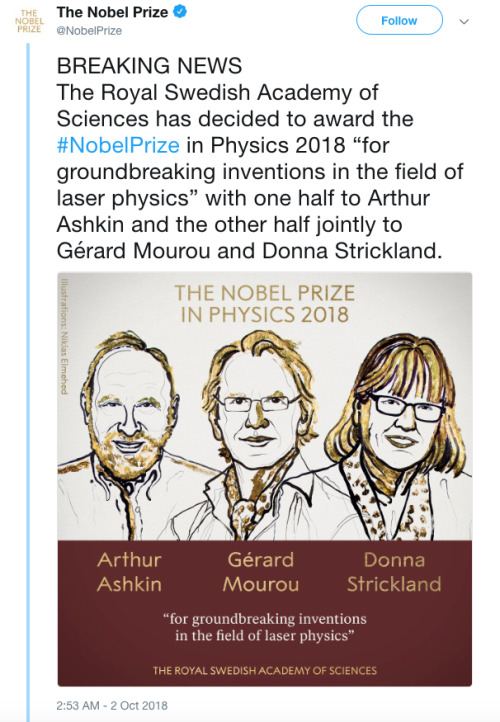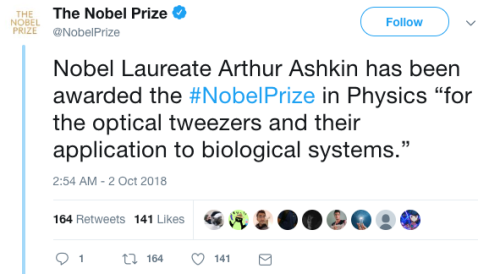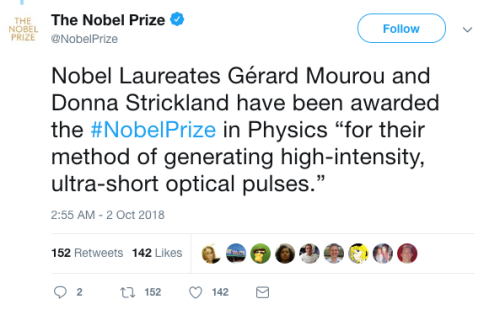Physics - Blog Posts
In this video, mixtures of inks (likely printer toners) and fluids move and swirl. Magnetic fields contort the ferrofluidic ink and make it dance, while less viscous fluids spread into their surroundings via finger-like protuberances. (Video credit and submission: Antoine Delach)

Despite its appearance, there is order in the chaos of turbulence. These snapshots from a turbulent channel flow simulation outline these coherent structures in black. The top photo shows a top view looking down on the channel and the bottom image shows a side view of the channel. It is thought that studying these coherent structures may help shed light on turbulence and its formation, which remains one of the great open questions of classical physics. (Photo credit: M. Green)

What is the shape of a falling raindrop? Surface tension keeps only the smallest drops spherical as they fall; larger drops will tend to flatten. The very largest drops stretch and inflate with air as they fall, as shown in the image above. This shape is known as a bag and consists of a thin shell of water with a thicker rim at the bottom. As the bag grows, its shell thins until it ruptures, just like a soap bubble. The rim left behind destabilizes due to the surface-tension-driven Plateau-Rayleigh instability and eventually breaks up into smaller droplets. This bag instability limits the size of raindrops and breaks large drops into a multitude of smaller ones. The initial size of the drop in the image was 12 mm, falling with a velocity of 7.5 m/s. The interval between each image is 1 ms. (Photo credit: E. Reyssat et al.)
Superfluids, a special type of fluid located below the lambda point near absolute zero, exhibit some mind-bending properties like zero viscosity and zero entropy. They are, in essence, a macroscopic manifestation of quantum mechanics. Here their thermomechanical, or fountain, effect is explained. This bizarre state of matter isn’t only found in laboratories, though. Scientists now think that superfluids may exist at the heart of neutron stars.
[Like Kurt Gödel and Alan Turing] I am also besotted with mathematics… I am absolutely struck with the power of mathematics, and that’s why I’m a theoretical physicist. If I want to answer questions, I love that we can all share the mathematical answers. It’s not about me trying to convince you of what I believe or of my perspective. We can all agree that one plus one is two, and we can all make calculations that come out to be the same, whether you’re from India or Pakistan or, you know, Oklahoma.
Magnificent On Being interview with cosmologist and theoretical physicist Janna Levin, who studies black holes, is the author of a bewitching novel about Kurt Gödel and Alan Turing, and has written beautifully about the relationship between genius and madness. (via explore-blog)
A sand pendulum that creates a beautiful pattern only by its movement.
But why does the ellipse change shape?
The pattern gets smaller because energy is not conserved (and in fact decreases) in the system. The mass in the pendulum gets smaller and the center of mass lowers as a function of time. Easy as that, an amazing pattern arises through the laws of physics.
Apply timeviewers.org equations and mathematics to stabilizing wormholes and detection of projections such as whole or partial masks for souls, and falsely sourced wormhole communications or projections.
Hannah Reber, “snowmotion”, 2013, video study



Breaking News:
The Nobel Prize in Physics for 2018 has been awarded to Arthur Ashkin, Gerard Mourou and Donna Strickland “for groundbreaking inventions in the field of laser physics”.
Donna Strickland is the first woman to win the Nobel Prize in Physics in 55 years.
Nobel Laureate Arthur Ashkin has been awarded the #NobelPrize in Physics “for the optical tweezers and their application to biological systems.”
Nobel Laureates Gérard Mourou and Donna Strickland have been awarded the #NobelPrize in Physics “for their method of generating high-intensity, ultra-short optical pulses.”
Article here with more information about their work:
Arthur Ashkin, Gérard Mourou and Donna Strickland win Nobel physics prize

Atomic-level motion may drive bacteria’s ability to evade immune system defenses
A study from Indiana University has found evidence that extremely small changes in how atoms move in bacterial proteins can play a big role in how these microorganisms function and evolve.
The research, recently published in the Proceedings of the National Academy of Sciences, is a major departure from prevailing views about the evolution of new functions in organisms, which regarded a protein’s shape, or “structure,” as the most important factor in controlling its activity.
“This study gives us a significant answer to the following question: How do different organisms evolve different functions with proteins whose structures all look essentially the same?” said David Giedroc, Lilly Chemistry Alumni Professor in the IU Bloomington College of Arts and Sciences’ Department of Chemistry, who is senior author on the study. “We’ve found evidence that atomic motions in proteins play a major role in impacting their function.”
Daiana A. Capdevila et al, Entropy redistribution controls allostery in a metalloregulatory protein, Proceedings of the National Academy of Sciences (2017). DOI: 10.1073/pnas.1620665114
The scientists conducted their experiments in Staphylococcus aureus, a common cause of skin, sinus and lung infections. Credit: Centers for Disease Control and Prevention

If you dropped a water balloon on a bed of nails, you’d expect it to burst spectacularly. And you’d be right – some of the time. Under the right conditions, though, you’d see what a high-speed camera caught in the animation above: a pancake-shaped bounce with nary a leak. Physically, this is a scaled-up version of what happens to a water droplet when it hits a superhydrophobic surface.
Water repellent superhydrophobic surfaces are covered in microscale roughness, much like a bed of tiny nails. When the balloon (or droplet) hits, it deforms into the gaps between posts. In the case of the water balloon, its rubbery exterior pulls back against that deformation. (For the droplet, the same effect is provided by surface tension.) That tension pulls the deformed parts of the balloon back up, causing the whole balloon to rebound off the nails in a pancake-like shape. For more, check out this video on the student balloon project or the original water droplet research. (Image credits: T. Hecksher et al., Y. Liu et al.; via The New York Times; submitted by Justin B.)


The multiverse might not be madness after all.
Alternate realities, parallel dimensions, and multiple universes. Whatever you call it, the notion of other versions of existence is one of the most popular tropes in science fiction. In some other universe, you’re not reading this sentence but skydiving. In another, you’re nothing but a cockroach. In yet another, not only is life impossible, but atoms don’t even exist.
In recent years, though, such seemingly crazy ideas have shifted from fantasy and speculation toward bona fide science. Even among physicists, the multiverse has gone mainstream.
Theoretically, infinite universes might stretch beyond our own, like endless bubbles in a sea of boiling water. Each bubble has its own laws of physics, and although we may never visit or even see another bubble, some physicists say growing evidence is making the multiverse increasingly plausible—and even probable. Learn more here.
With the simplest assumptions, you end up with eternal inflation and the multiverse. Being conservative on that front lands you at this radical thing.
Physicist Andreas Albrecht of the University of California, Davis. The idea of a multiverse might not be as crazy as it sounds. (via sciencefriday)

Popcorn’s explosive pop looks pretty cool in high-speed video, but just watching it with a regular camera doesn’t show everything that’s going on. If we take a look at it through schlieren optics, the kernel’s pop looks even more extraordinary:

The schlieren technique reveals density differences in the gases around the corn–effectively allowing us to see what is invisible to the naked eye. The popcorn kernel acts like a pressure vessel until the expansion of steam inside causes its shell to rupture. The first hints of escaping steam send droplets of oil shooting upward. The kernel may hop as steam pours out the rupture point, causing the turbulent billowing seen in the animation above. As the heat causes legs of starch to expand out of the kernel, they can push off the ground and propel the popcorn higher. As for the eponymous popping sound, that is the result of escaping water vapor, not the actual rupture or rebound of the kernel! See more of the invisible world surrounding a popping kernel in the video below. (Image credits: Warped Perception, source; Bell Labs Ireland, source; WP video via Gizmodo; BLI video submitted by Kevin)

In the Alice in Wonderland world of the atomically small, things can be in two places at once, merely looking at a particle can alter a twin on the other side of the universe apparently instantaneously, and theoretical cats can be both alive and dead.
Certainty is also somehow replaced by chance, an idea that once moved a somewhat vexed Albert Einstein to famously say: “God doesn’t play dice with the universe.”
Such strange, almost magical effects have always been confined to the world of photons and atoms – until now.
In the journal Nature, scientists at the US National Institute of Standards and Technology (NIST) in Colorado reported the first “glimpses” of quantum effects, as they are known, happening on a scale just large enough to be seen by the human eye.
It is a breakthrough that could have significant implications for attempts to create quantum computers that are many millions of times faster than the current machines.
One of the researchers, Dr John Teufel, told the Independent: “I think we’re in an extremely exciting time where this technology we have available gives us access to things people have been talking about as thought experiments for decades.
“Just now what’s exciting is we can go into the laboratory and actually witness these quantum effects.”
Continue Reading.

As the element that makes up 75 percent of all the mass in the Universe, and more than 90 percent of all the atoms, we’re all pretty well acquainted with hydrogen.
But the simplest and most abundant element in the Universe still has some tricks up its sleeve, because physicists have just created a never-before-seen form of hydrogen - negatively charged hydrogen clusters.
To understand what negatively charged hydrogen clusters are, you first have to wrap your head around their far more common counterparts - positively charged hydrogen clusters.
Positively charged hydrogen clusters are pretty much exactly what they sound like - positively charged clusters of a few or many hydrogen molecules.
Known simply as hydrogen ion clusters, they form at very low temperatures, and can contain as many as 100 individual atoms.
Physicists confirmed the existence of hydrogen ion clusters some 40 years ago, and while a negative counterpart to these clusters boasting large numbers of atoms were theorised, no one could figure out how to create one.
But that didn’t stop a team of physicists led by Michael Renzler from the University of Innsbruck in Austria from giving it a shot.
Continue Reading.

R.I.P. Vera Rubin; 1928-2016.
She never did win the Nobel prize for her discovery.
Watching a snowflake grow seems almost magical–the six-sided shape, the symmetry, the way every arm of it grows simultaneously. But it’s science that guides the snowflake, not magic. Snowflakes are ice crystals; their six-sided shape comes from how water molecules fit together. The elaborate structures and branches in a snowflake are the result of the exact temperature and humidity conditions when that part of the snowflake formed. The crystals look symmetric and seem to grow identical arms simultaneously because the temperature and humidity conditions are the same around the tiny forming crystals. And the old adage that no two snowflakes are alike doesn’t hold either. If you can control the conditions well enough, you can grow identical-twin snowflakes! (Video credit: K. Libbrecht)

It’s a textbook moment centuries in the making: more than 200 years after scientists started investigating how water molecules conduct electricity, a team has finally witnessed it happening first-hand.
It’s no surprise that most naturally ocurring water conducts electricity incredibly well - that’s a fact most of us have been taught since primary school. But despite how fundamental the process is, no one had been able to figure out how it actually happens on the atomic level.
“This fundamental process in chemistry and biology has eluded a firm explanation,” said one of the team, Anne McCoy from the University of Washington. “And now we have the missing piece that gives us the bigger picture: how protons essentially ‘move’ through water.”
Continue Reading.

Bismuth is one of the weirdest-looking elements on the Periodic Table, but its internal properties just got even stranger. Scientists have discovered that at a fraction of a degree above absolute zero (-273.15°C), bismuth becomes a superconductor - a material that can conduct electricity without resistance.
According to the current theory of superconductivity, that doesn’t make a whole lot of sense, because for 40 years now, scientists have assumed that superconducting materials must be abundant in free-flowing mobile electrons. But in bismuth, there’s just one mobile electron for every 100,000 atoms.
“In general, compounds that exhibit superconductivity have roughly one mobile electron per atom,” Srinivasan Ramakrishnan from the Tata Institute of Fundamental Research in India explained to Chemistry World.
“However, in bismuth, one mobile electron is shared by 100,000 atoms – since [the] carrier density is so small, people did not believe bismuth will superconduct.”
Continue Reading.
Here’s something cool to do with your leftover candy corn – all you have to do is head to space.
Astronauts are allowed to bring special “crew preference” items when they go up in space. NASA astronaut Don Pettit chose candy corn for his five and a half month stint aboard the International Space Station. But these candy corn were more than a snack, Pettit used them for experimentation.
See how he did it:
The brilliant colors of a soap film reveal the fluid’s thickness, thanks to a process known as thin film interference. The twisting flow of the film depends on many influences: gravity pulls down on the liquid and tends to make it drain away; evaporation steals fluid from the film; local air currents can push or pull the film; and the variation in the concentration of molecules – specifically the surfactants that stabilize the film – will change the local surface tension, causing flow via the Marangoni effect. Together these and other effects create the dancing turbulence captured above. (Video credit: A. Filipowicz)
This guy gets it
i find it so unfair that i cant do all the science. like what do you MEAN I can't study bio and chem and biochem and atrophysics and physics and geology and climate science. what do you MEAN i have a limited lifespan and need to get out of school at some point to get a job. i want to collect the science fields like pokemon, this isn't fair



6 march 2025
hihiiii <3
very basic day, i gotta revise all 14 chapters of physics cuz tmr’s my final 🥲 but yay, i started at 12 and finished revising 4 chapters (questions + derivations and notes) so pretty happy about how much i got done, it’s gonna be a long night again (when is it not) but i really hope my exam goes well tmr (cbse physics paper reactions scared me)
there’s also a rumour that i could have my math board re exam cuz the paper got leaked (😭😭😭) i might actually cry if that happens cuz math is genuinely my weakest subject, tho it’s fun, i really can’t bring myself to study that subject again.
anyways -
todo list 🎀
i still need to learn ray optics cus i skipped it all year
revise :
magnetism and matter
electromagnetic induction
alternating current
electromagnetic waves
wave optics
atoms, nuclei
dual nature (might skip)
semi conductors
i think i’ll be done with revising by around mid night and then i’ll go through the numericals and formulas again
also i did plan to finish reading ncert by the time my exams end but i really doubt ill do that 😭 boards is already a load of work, trying to fit in 11th bio is a real task so maybe i’ll just finish 11th biology by the end of march. i’ll already be reading 12th bio for boards so only 11th would be manageable after exams.
anyways,
have a nice day loves <3
💌
I'm sick and tired of the lack of stem dark academia vibes in modern literature. Obviously we have Frankenstein, which I love, but I am foaming at the mouth for a book like The Secret History, or Bunny, or Dead Poet Society but stem.
Imagine a murder mystery at a prestigious university, but it's a sleep-deprived physics student who's obsessed with space, an equally as tired chemistry student that's only a ~little~ unhinged and overexcited for orgo lab, and a medicine student who spent an entire week studying anatomy getting together to solve it.
Or, they all suspect each other, though nobody knows that they do, and the actual murderer attempts to sabotage the group effort without being caught.





